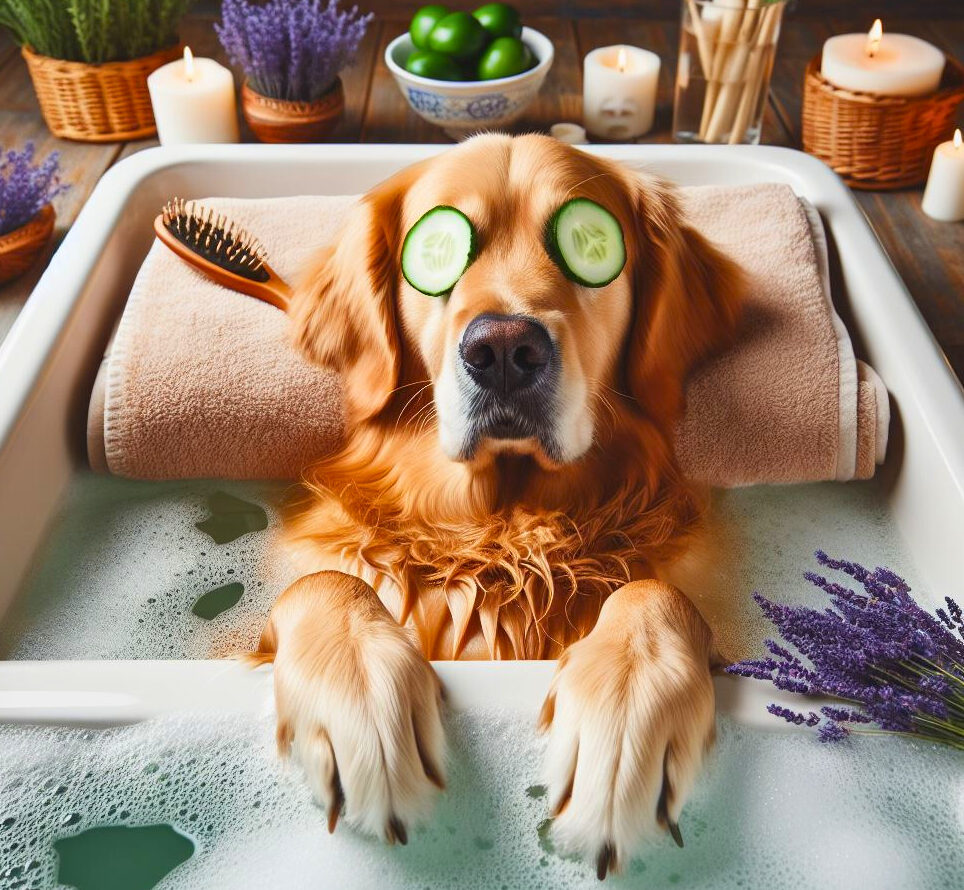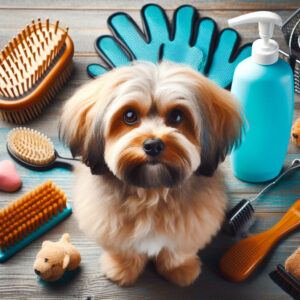Debunking Common Pet Grooming Myths:
A Guide to Optimal Pet Care

I will start by clarifying a few frequently presented misconceptions about pet grooming. This is about removing fluff and dispelling myths that harm your pet’s well-being.
- Let’s start by addressing the widespread misperception that grooming is synonymous with overindulging your pet. For some people, grooming is a luxury that should only be indulged in occasionally or when caring for a high-maintenance pet. But it’s crucial to realize that grooming goes beyond pampering; it’s a fundamental part of pet care and necessary for any breed’s well-being, regardless of size, temperament, or degree of activity.
- Another myth that needs to be busted is that cats can groom themselves to perfection. Although cats are renowned for their meticulous self-cleaning habits, it’s crucial to understand that they still benefit from extra assistance with grooming. Expert grooming services can reduce problems like hairballs, avoid matting in their coat, and preserve the condition of their skin.
- Furthermore, you should reevaluate your belief that short-haired pets do not need regular care. Despite what many people think, all pets require regular grooming, regardless of the length of their coat. Frequent grooming procedures allow you to check for parasites and other possible health issues and remove loose hair, dander, and filth.
- Lastly, a common misunderstanding is that grooming is limited to improving a pet’s appearance. Grooming undoubtedly enhances appearance, but its importance goes far beyond aesthetic appeal. It is an essential practice that allows one to identify health problems early on, before they become serious. This emphasizes the health benefits of regularly maintaining your pet’s grooming routine.
Understanding the Health Benefits of Regular
Pet Grooming
Consider routine grooming sessions as preventative steps similar to early warning systems for various health problems. By giving your pet complete brush-outs and inspections, you can detect minor changes in its body, such as skin irregularities or lumps that go unnoticed. This allows you to treat possible health issues before they arise.
The following elements should be taken into account when creating a grooming schedule for your pet:
BREED AND SPECIES: Grooming needs differ depending on the breed and species. For instance, short-haired breeds might require less upkeep in this area, but long-haired breeds might need more frequent brushing to avoid matting and tangling.
TYPE OF COAT: Consider your pet’s coat type when assessing grooming requirements. Double-coated dogs and cats may shed more frequently and need more frequent brushing to remove loose fur and avoid matting during shedding seasons.
LIFESTYLE: Your pet’s grooming requirements may also be impacted by their way of life. While indoor pets may require less regular bathing but greater attention to nail trimming and dental care, outdoor pets may require more frequent bathing to remove dirt and odors.
REGARDING HEALTH: Special grooming considerations may be necessary for medical problems like skin allergies or arthritis. A grooming regimen that considers your pet’s health must be developed with your veterinarian.
SENSITIVITIES AND PREFERENCES: When brushing your pet, consider its preferences and sensitivities. While some pets find grooming and bonding enjoyable, others might find it unsettling. Adjust your technique appropriately to guarantee your pet has a pleasant grooming session.
Regular grooming sessions will enhance your bond with your pet and help them maintain maximum health and hygiene. You can customize your pet’s grooming schedule based on their specific needs.

Your pet’s skin must remain in optimal condition. Grooming may be compared to a relaxing spa treatment that helps your pet get rid of dirt and debris, increases blood flow, and ensures that your pet’s coat is evenly coated with natural oils. Never undervalue the importance of this vital procedure since your pet’s general health and happiness depend heavily on having good skin and coat.
Of course! Nail care is essential to our pets’ general health. Long nails can impair their mobility and cause pain, resulting in discomfort and even health issues. Regular nail cutting guarantees comfort when running or walking, helps them maintain good posture, and avoids joint problems. It’s a crucial component of pet care that must not be disregarded.
To ensure your pet receives the proper care, it’s essential to determine its unique grooming requirements. Grooming needs vary depending on breed, coat type, activity level, and underlying medical issues. Professional groomers are qualified to perform a wide range of duties effectively and safely, which is particularly advantageous for special needs pets or pets who feel uneasy during grooming sessions.
Choosing the Right Grooming Services for Your Pet
When grooming your pet, one size does not fit all. To keep your furry friend looking and feeling its best, you must tailor its grooming routine to suit its unique needs, which vary widely based on species, breed, and lifestyle. For example, dogs that spend much time outdoors may require more frequent brushing to remove dirt and debris, while indoor cats might need fewer frequent nail trims.
You might be wondering about the difference between taking on the grooming yourself or opting for a professional. While home grooming can be a bonding experience and is great for maintenance, professionals have specialized tools and training to safely handle the tough jobs – like dealing with matted fur or clipping nails. They’re also trained to spot potential health issues that might go unnoticed.
Benefits of Professional Pet Grooming:
Expertise: To ensure your pet receives the best care possible, professional groomers are trained to undertake various grooming activities, such as bathing, haircuts, and nail trimming.
Equipment: Products and tools specifically made for pet grooming are available in grooming salons; these items might not be easily found for at-home grooming.
Convenience: Compared to grooming your pet at home, professional grooming services are more convenient and save you time and effort.
Cons of Maintaining a Professional Appearance:
Cost: Hiring a professional groomer can be costly, particularly for pets that need to be groomed frequently.
Stress: During salon grooming appointments, pets may feel anxious or stressed, especially if they are uncomfortable with their surroundings or the groomer.
Availability: Making an appointment at a grooming salon may need planning ahead and slots may fill up quickly during busy periods.
At-home grooming may be a good choice for pet owners who would rather groom their animals themselves or for animals who might feel more at ease in familiar circumstances. It guarantees your pet’s safety and well-being; therefore, you must make the appropriate investments in grooming supplies and equipment and educate yourself on appropriate grooming methods.
The Necessities for At-Home Pet Grooming:
Grooming Supplies
Invest in high-quality supplies appropriate for your pet’s coat type and grooming requirements, such as brushes, combs, nail clippers, and scissors.
Products safe for pets: Use pet-specific shampoos, conditioners, and grooming supplies to prevent skin irritation and allergic reactions.
Patience and positive reinforcement: To help your pet feel at ease and content during grooming sessions, approach the process with patience and a composed attitude.
Regular care: Set up a regular grooming schedule to maintain the health and cleanliness of your pet’s coat, nails, ears, and teeth.
The choice between in-home and professional grooming ultimately comes down to your budget, personal tastes, and your pet’s particular needs. Putting your pet’s happiness and health first is essential, no matter which grooming method you decide on.
Grooming Your Pet:
Practical Pet Grooming Tips and Best Practices
Let’s look at some helpful advice to ensure your pet grooming sessions are enjoyable and successful. Understanding your pet’s grooming needs is a crucial first step. Since every breed is different, what works for one might not work for another. For example, the coats of a Poodle or Persian cat may require more maintenance than those of a Labrador or Siamese cat

- Of course, let’s explore some essential equipment and supplies that will significantly improve your grooming experience. We’re talking about grooming gloves, slicker brushes, and choosing the right shampoo based on your pet’s unique skin type. When in doubt, it’s always a good idea to see a veterinarian or an experienced professional groomer before trying out new items.
- It’s critical to comprehend how comfortable your pet is. There should never be a bad grooming experience. It’s important to gradually introduce grooming activities while providing lots of goodies and encouraging feedback. Thanks to your kind approach and patience, you and your pet will both appreciate and feel less stressed during future grooming sessions.
- The grooming industry is changing quickly, highlighting how crucial it is to stay current with best practices. Professional grooming might seem like a luxury, but it’s a necessity for certain pets. Never be afraid to ask for help from experts in the area if you have any doubts or if your pet needs more grooming than you can provide. Their knowledge can guarantee that your pet gets the attention it needs.
- It’s pretty typical for your first attempts at grooming to feel a little awkward. Your grooming abilities will improve as you learn more about your pet’s requirements and preferences. Recall that loving and caring for your pet during grooming is more important than striving for perfection.
- I hope these insights will enable you to handle your pet’s grooming needs more proactively. Now that you are more knowledgeable about the fundamentals of pet care, you can concentrate on making sure your furry family member stays in good condition and looks and feels great. Recall that a helpful network of pet owners and professionals is available to support you at every turn on this path. You are not alone.
If you have any questions, personal experiences or tips to share, I’d love your feedback. Please make comments below. Thanks for joining me on this journey regarding misunderstandings about pet grooming!
-Janice-

I do Like reading your articles on pet grooming, it’s full of very useful information and advice!
Especially the part about spotting underlining health issues, with skin conditions, that could be the key to other pending problems!
The pros and cons to grooming your pets is also valuable I information as it allows the reader to make that decision on whether to seek a professional groomer or DIY it!
Thanks for sharing your insight into pet grooming, it’s a great read!
Keep up the good work.
Julia. 🙂
I’m glad you enjoyed reading the articles regarding pet grooming.
Yes, there are various pending problems that the pet owner can be made aware of during grooming and/or brushing, such as sores or lumps, which can be addressed hopefully before it becomes a larger problem situation.
Sundry variables ultimately dictate the decision-making process of seeking a professional pet groomer or whether one might feel confident in grooming one’s pet(s).
Thank you, Julia, for your kind and thoughtful comments!
Janice